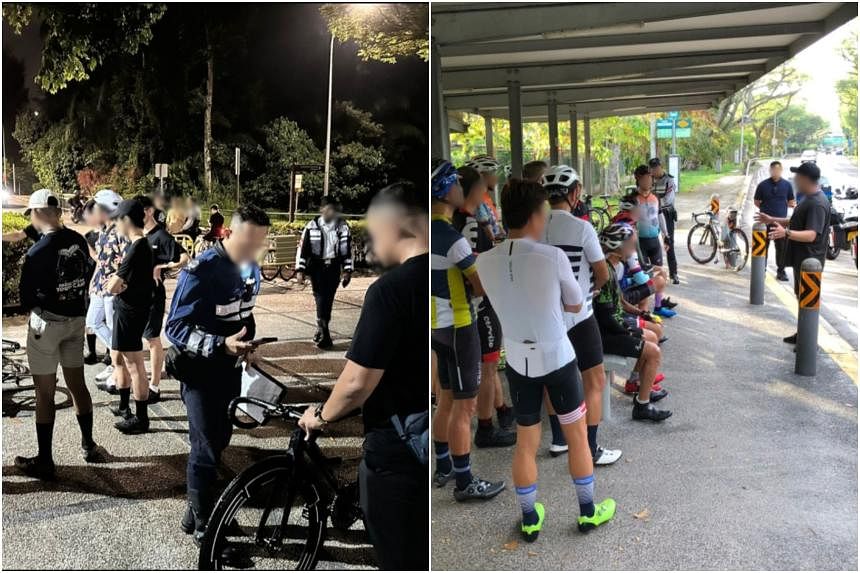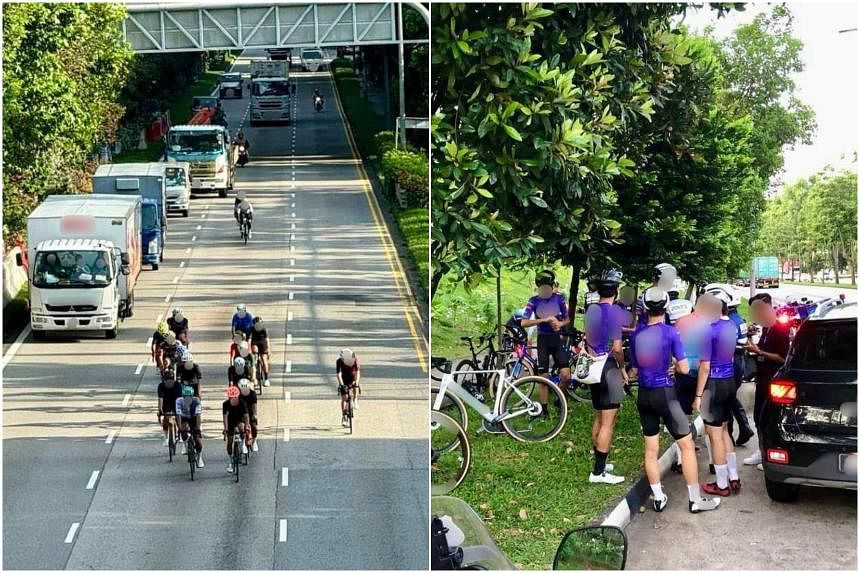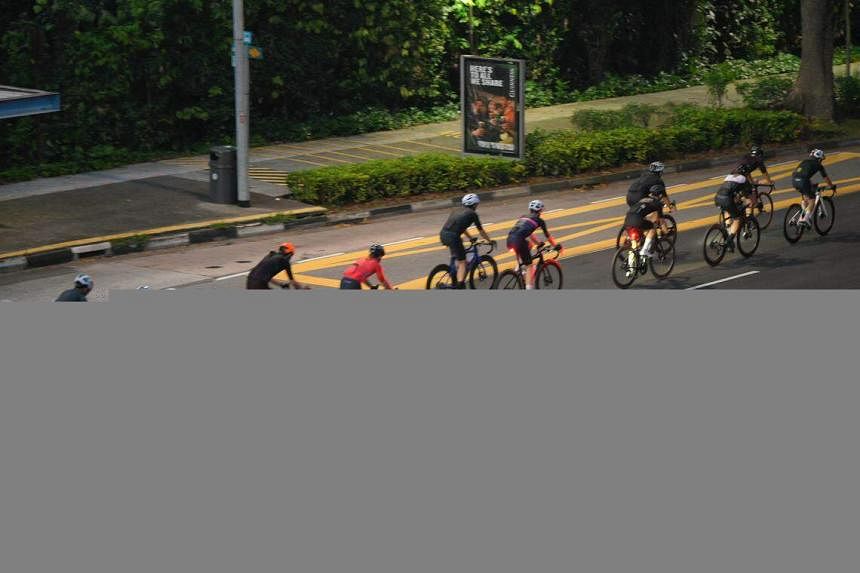Over 25 cyclists caught by LTA, Traffic Police for riding in groups larger than permitted
The cyclists were caught along Clementi Road and West Coast Highway in the latest round of operations by LTA and the Traffic Police. PHOTOS: LTA
Esther Loi,
Whitney William and
Therese Soh
MAY 27, 2024
SINGAPORE – More than 25 cyclists were caught on the morning of May 25 for riding in groups that were larger than permitted.
The Land Transport Authority (LTA) said on Facebook later in the day that the cyclists were caught along Clementi Road and West Coast Highway in its latest round of operations with the Traffic Police (TP) against errant cyclists.
Current restrictions, which took effect in January 2022,
limit cyclists riding in groups to five if cycling in a single file, or 10 cyclists riding two abreast.
The authorities also advise maintaining a minimum distance of 30m – the equivalent of two lamp posts – between cyclist groups.
In a similar joint enforcement operation by LTA and the TP from the end of April to early May 2024, 16 cyclists were caught for riding in a group larger than 10. Six others were found with non-compliant manual bicycles without a functioning handbrake.
These operations took place in Dunearn Road and Pasir Panjang Road as well as the Woodlands Waterfront area.
Cyclists who flout the rule on group size can be fined $150.
Challenges faced by group cyclists
Seasoned group cyclists told The Straits Times that they try their best to follow the rules, although they do not fully understand the rationale behind group cycling restrictions.
On Jan 1, 2022, the Ministry of Transport (MOT) rolled out recommendations by the Active Mobility Advisory Panel (Amap) to place a cap on cyclist groups, as it will ensure that the space they occupy is similar to that of a bus.
For the group size limit, Amap had said bigger cyclist group sizes
increased the difficulty in maintaining orderly and predictable conduct among members, which could increase the risks for riders themselves. It added that the gap between cyclist groups would leave enough space for overtaking vehicles.
A member of the Singapore West Cyclist community, Mr Khaw Cheng Chuan, 44, who is head of platform at an information technology firm, said there can be situations where other cycling groups may ride close to his due to the road or traffic conditions, without maintaining a minimum distance of 30m.
But the entire pack of cyclists, including his own group that tried to abide by the rules, may be penalised if enforcement officers catch them at that moment.
Mr Vareck Ng, 22, a member of cycling groups Slow Biking Singapore and Safety for Active Mobility Users, said it is challenging to constantly ensure a 30m gap between different cycling groups, especially while in motion on a bicycle.
The soon-to-be university student noted that this draws cyclists’ attention away from focusing on the road and oncoming traffic.
Stepping up education efforts among all road users, policing errant behaviour among drivers and building cycling-centric infrastructure were among the suggestions group cyclists had to improve road safety for their community.
As some motorists and road users still view cyclists as an annoyance, Mr Marco Mejia, 41, president of Singapore-based cycling community Anza (Australian and New Zealand Association) Cycling, said building their empathy for cyclists will be crucial.
“It is a very small window of inconvenience when you wait for five seconds behind a group of cyclists... It’s more about creating the harmonious sharing of the roads,” he added.
Mr Lawrence Choo, 45, founding member of cycling enthusiast groups 10101010 and Faber X, suggested that the guideline for motorists to adhere to a minimum distance of 1.5m when passing cyclists on roads be passed into law, so that it can be enforced like the group cycling rules.
He added that drivers should learn that cyclists also have a right to be on the roads.
Mr Kiki Matthias Cheng, founder of cycling enthusiast group Riding Kakis (Singapore), said it may be more effective to influence cyclists to become role models who “walk the ground” and advocate safer cycling practices within their cycling groups.
The 52-year-old operations director added that this could help “activate” the cycling community in spreading good cycling practices, compared with a top-down approach through law enforcement.
Mr Khaw and Mr Ng both suggested building more dedicated cycling infrastructure, such as cycling lanes that allow road users to give cyclists the right of way.
There are now 525km of cycling paths in Singapore and the cycling path network
will be expanded to around 1,300km by 2030.
An LTA spokeswoman said some cyclists had expressed the view that riding abreast and in groups increased their visibility and safety. Conversely, motorists had raised concerns about very large groups of cyclists posing safety risks, especially if they occupy multiple lanes and obstruct traffic.
To strike a balance between these concerns, LTA introduced the limit on cycling group sizes, she said.
LTA also developed a road safety handbook in consultation with the TP, various road users and the industry to guide motorists and cyclists on ways to safely navigate common scenarios on the roads.
Current restrictions limit cyclists riding in groups to five if cycling in a single file, or 10 cyclists riding two abreast. ST PHOTO: MARK CHEONG
Mr Steven Lim, 57, vice-president for safety and education at the Singapore Cycling Federation, said cyclists should observe the rule on maintaining a 30m gap between groups and avoid riding close to cycling groups ahead of them.
If a group tries to follow the rules but gets caught by an enforcement officer due to cyclists behind them riding too close, the group can explain that it is not at fault.
Mr Lim is a member of Amap and was involved in the panel’s fifth review to enhance road safety, where it put forth the recommendations that MOT rolled out.
‘Inconvenient’ to drive behind group cyclists
Drivers told ST it can be inconvenient to drive behind some cyclists travelling in groups.
Management team member Sanjeev Namath, 56, found that some cyclists often ride in the middle of the road, hogging the lane. He felt that some groups with no “discipline” in following the rules were harder to coexist with on the roads.
Student Rhea Kenneth, 22, found it “inconvenient” to drive behind cyclists she is unable to overtake, which results in her reducing her speed to match theirs. This holds up traffic behind her.
Motorcyclist Galvin Lim, 29, found it quite easy to navigate around cyclists on the roads. But it becomes more dangerous when he comes across groups that ride in a less coordinated manner.
“They swerve from left to right, and usually in areas where cars and bikes tend to speed up. It’s more dangerous as it causes cars to swerve out to overtake,” said the sales manager.
Motorcyclist Satria Mad, 43, has mostly encountered cyclists who abide by the rules. The assistant operations manager said sharing the road with cyclists has been easy because many cyclists are aware of the rules.




